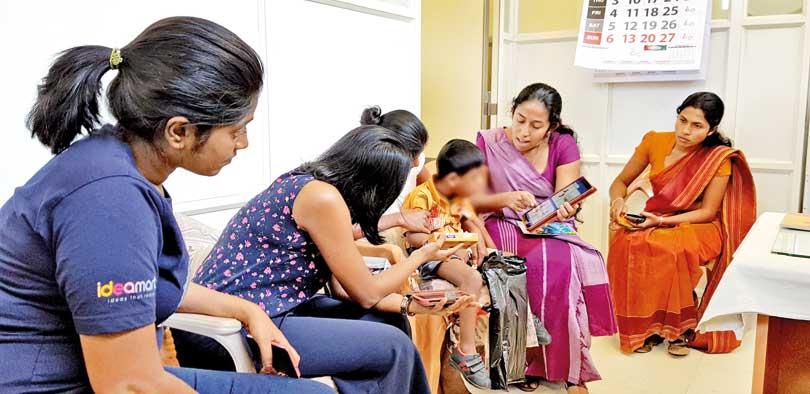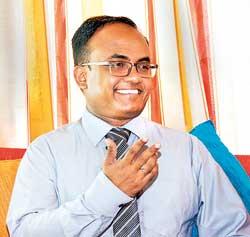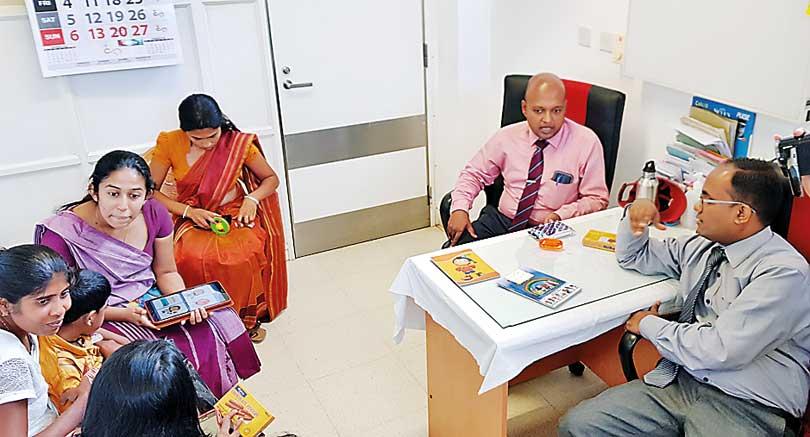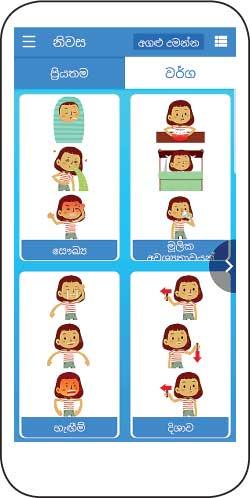Reply To:
Name - Reply Comment

“One of the most sincerest forms of respect is actually listening to what another has to say”.-Bryant McGill
 The inability to express oneself adequately can be a very frustrating experience. Crying out aloud is the only form of self-expression in infants and as they grow older, social cues are picked up and the concept of language enters their lives, finally enabling them to communicate with the world. New parents are in a constant state of panic during the first few months post childbirth as the child begins to communicate and understanding grows. However, in children with speech and language disorders, this process is more challenging and can lead to gaps in communication due to inadequate self-expression as well as understanding. The basic needs of these children are fulfilled, however their wants, likes and preferences remain overlooked and thus, children whose brain functions are usually very much intact, are compelled to lead monotonous lives and this takes a toll on the emotional well-being as well.
The inability to express oneself adequately can be a very frustrating experience. Crying out aloud is the only form of self-expression in infants and as they grow older, social cues are picked up and the concept of language enters their lives, finally enabling them to communicate with the world. New parents are in a constant state of panic during the first few months post childbirth as the child begins to communicate and understanding grows. However, in children with speech and language disorders, this process is more challenging and can lead to gaps in communication due to inadequate self-expression as well as understanding. The basic needs of these children are fulfilled, however their wants, likes and preferences remain overlooked and thus, children whose brain functions are usually very much intact, are compelled to lead monotonous lives and this takes a toll on the emotional well-being as well.
 In such situations both the caregiver as well as the child gets frustrated as for their inability to communicate effectively with their loved ones. The Athuru Mithuru app recently launched by Dialog Axiata (PVT) Ltd, at the Anuradhapura Teaching Hospital, is the latest tool which has begun to offer a new hope to such families. This app is freely download-able, and does not require a constant internet connection for usage.
In such situations both the caregiver as well as the child gets frustrated as for their inability to communicate effectively with their loved ones. The Athuru Mithuru app recently launched by Dialog Axiata (PVT) Ltd, at the Anuradhapura Teaching Hospital, is the latest tool which has begun to offer a new hope to such families. This app is freely download-able, and does not require a constant internet connection for usage.
A speech disorder refers to a problem with the actual production of sounds, such as difficulty in articulating words, stuttering, and issues with controlling the pitch, quality and volume of the voice. Some children even experience pain and discomfort while speaking or producing a sound, which can contribute to the development of a speech disorder. Language disorders, on the other hand, refer to challenges in expressing and understanding, where a child is unable to communicate in a comprehensible manner. There is difficulty in putting words together to express thoughts and ideas and in processing the language and understanding what is being said.
Initial assessment is done by speech therapists, assessing basic details such as tongue movements and the ability of the patient to swallow - Dr Himantha Atukorale
Speech therapy is required in such children and the earlier the problem is identified, and addressed, better the outcome, says Dr. Himantha Atukorale, Consultant in Rheumatology and Rehabilitation at the Anuradhapura Teaching Hospital which is the third largest teaching hospital in the country. Among many other departments, the Anuradhapura Teaching Hospital houses a department of speech therapy, dedicated to address development delays, including speech delay.
‘Speech delays are usually detected during routine paediatric assessments” says Dr. Atukorale, giving a comprehensive account on identifying and addressing speech and language disorders. “All children, especially under the age of 3 undergo routine paediatric assessments, where “developmental milestones” are evaluated. For Example, at 10 months of age, a child should ideally be able to speak at least one word with a purpose, and at around 2 years of age, the child should be able to say two or three worded sentences. If a delay in achieving these milestones are detected, the paediatrician refers the patient to the department of speech therapy. Initial assessment is done by speech therapists, assessing basic details such as tongue movements and the ability of the patient to swallow. Upon identifying the problem, speech-rehabilitation therapy specifically designed for the detected defect, is begun.”
Currently, three speech therapists are available at the Anuradhapura Teaching Hospital along with two more trainee therapists. Pronunciation is addressed initially and the therapists begin with sounds, progress to simple nouns and finally, verbs. Face to face training is vital for speech therapy, and the child is brought in to spend some time in the clinic, where rapport is established and the child is made comfortable.
AAC could be achieved using low-tech devices, such as picture cards, objects, a picture communication books/boards or by using high-tech devices such as smart phones, tablets or any electronic device in which an app can be used
As Dr. Atukorale further explains, “Augmentative and Alternative Communication Tools” are an integral part of the therapy. These tools have prevailed for decades, and the most basic of this type are pictures and play cards with simple words, commands and even emotions, designed to train the child to identify the picture and pronounce the word correctly. Novel tools such as interactive toys have been introduced in the recent past, where buttons can be pressed and the corresponding word or sound can be heard. However these toys are expensive and children from families of below average income are unable to afford or access them. The latest advancement in speech therapy are smart device based apps that can be used in electronic communication devices. However these apps were available in English and the majority of patients were unable to benefit from these apps, as most Sri Lankans use their mother tongues to communicate at home, either in Sinhala or in Tamil. A free app that is customizable and preferably tri-lingual was the need of the hour. Athuru Mithuru, an app developed by Dialog Axiata, has seemed to have checked all the boxes. When the app was first introduced to the speech therapy department of the Anuradhapura Teaching Hospital, the speech therapists tested this app among the children.

“Hearing their child address them with love and having conversations with their children are among the many moments any parent would want to experience and cherish, yet, unfortunately not every parent or family member gets to satisfactorily communicate with their child or sibling” says Kalhari Dissanayake, the chief speech therapist at Anuradhapura Teaching Hospital, sharing her experiences on dealing with children who have special needs. “Being speech and language therapists, it is our responsibility to identify the ways of effective communication for a child or an adult who have difficulties in expressing themselves.
Alternative Augmentative Communication (AAC) is a mode of communication for those who have difficulty in expressing themselves verbally. For example, children with developmental medical conditions such as cerebral palsy, autism, or even children who experience speech and language delay without any medical conditions benefit from AAC. AAC could be achieved using low-tech devices, such as picture cards, objects, picture communication books/boards or by using high-tech devices such as smart phones, tablets or any electronic device in which an app can be used. A child can communicate via AAC using finger pointing, eye gazing or using emotions . Many high-tech AAC apps are available in English and other western languages and are not culturally suitable or appropriate for Sri Lankans. Some of these apps are not freely accessible. Very limited apps are found in Sinhala or Tamil language.
 The ATHURU MITHURU app introduced by Dialog, has created a milestone in providing a voice for the children who have difficulties in expressing themselves while giving the parents an opportunity to understand their child’s needs and feelings. It is an easily accessible low cost app even a parent can download and use it for their child’s communication as it provides clear instructions on how to use the app. Even in a clinical setting the app can be accessed via a smart phone or a tab to assess a child’s speech and language skills as well as to improve their communication skills. It consists of categories including the functional needs a child can have. The best thing is we can alter and add new categories, import pictures and import sound input for the picture that we use. For a child who can use finger pointing, can touch the picture that he wants and indicate the need with the sound output. Even when a child finds it difficult to use pointing, the caregiver can show the picture and identify the kid’s need from their facial expression or eye gaze. “According to my knowledge this app can be used as an effective tool as well as a bridge for functional communication and a voice for the children who have difficulties expressing themselves verbally. “ says Kalhari Dissanayake.
The ATHURU MITHURU app introduced by Dialog, has created a milestone in providing a voice for the children who have difficulties in expressing themselves while giving the parents an opportunity to understand their child’s needs and feelings. It is an easily accessible low cost app even a parent can download and use it for their child’s communication as it provides clear instructions on how to use the app. Even in a clinical setting the app can be accessed via a smart phone or a tab to assess a child’s speech and language skills as well as to improve their communication skills. It consists of categories including the functional needs a child can have. The best thing is we can alter and add new categories, import pictures and import sound input for the picture that we use. For a child who can use finger pointing, can touch the picture that he wants and indicate the need with the sound output. Even when a child finds it difficult to use pointing, the caregiver can show the picture and identify the kid’s need from their facial expression or eye gaze. “According to my knowledge this app can be used as an effective tool as well as a bridge for functional communication and a voice for the children who have difficulties expressing themselves verbally. “ says Kalhari Dissanayake.
Upon testing the effectiveness of this app, Dr. Atukorale and the speech therapists of Anuradhapura teaching hospital have noticed that this app had brought about significant improvement in children. Although not overnight, the app seemed to work. The app may be modified in future to suit the needs of even adults, whose verbal and expressive abilities have been compromised due to conditions such as strokes or head trauma. Toileting, medication , symptom alerts and discomforts are among the few useful things to be added, to benefit adult patient.
Renowned physicist Stephen Hawking, used a highly modifiable augmentative and alternative communicative device, which he used to deliver lectures of high standards. The potential and the capacity of such children is similar, for, in most cases, it is their communicating abilities that have been compromised and not their other higher cognitive functions. Dr. Atukorale shared an inspiring moment where he realized the true potential of such children. While watching a program called Britain’s got talent 2018, a popular TV reality show, a participant suffering from cerebral palsy, a condition that renders a person unable to communicate normally, ultimately emerged victorious. He couldn’t utter a word, yet, he used a tab based application to perform and express his creative thoughts and jokes.
ENT surgeons perform cochlear implants on those who have auditory impairments or are born deaf. When the cochlear implant is done, these children hear for the very first time in their lives and are absolutely clueless as to how sound and language work. So, such apps can be beneficial to such cases as well.
A speech disorder refers to a problem with the actual production of sounds, such as difficulty in articulating words, stuttering, and issues with controlling the pitch, quality andvolume of the voice
A campaign is to be launched where people will be requested to donate their used mobile devices, even the most basic ones of their type,to be distributed among the needy patients in the Anuradhapura district . As this app can be accessed via smart phones and tablets, financially challenged patients are unable to purchase their own devices, and rely on the hospital resources which they can access only when they visit the hospital. Especially in the north central province, where the app has now been introduced, almost all the patients involved face financial constraints and are unable to afford a smart device.
There remains a constant debate about the current generation and their dependency on smart devices leading to addiction, but in these children, these devices might be the only way to communicate in their otherwise lonely and silent world. Dr. Atukorale also hopes that this app will be tried out in other hospitals around the country as well. The dialog team had also provided a training to the speech therapists on how to use the app.
The ultimate goal of speech therapy is to bridge the communication gap, so these children can go on to be functioning adults who are independent and may even secure employment in future, says Dr. Atukorale, as his efforts are bearing obvious fruit. The importance of raising awareness and promoting rehabilitation is vital, as help can only be given when it is sought. Many such children in rural areas of the country are kept hidden, as parents fear social stigma, and are not even brought to therapy. Improvement in children who have already benefited hopefully serves as a ray of hope as well as an eye opener.